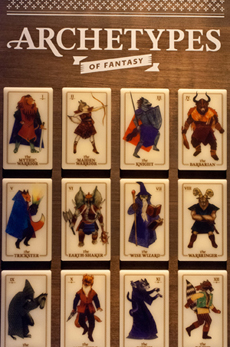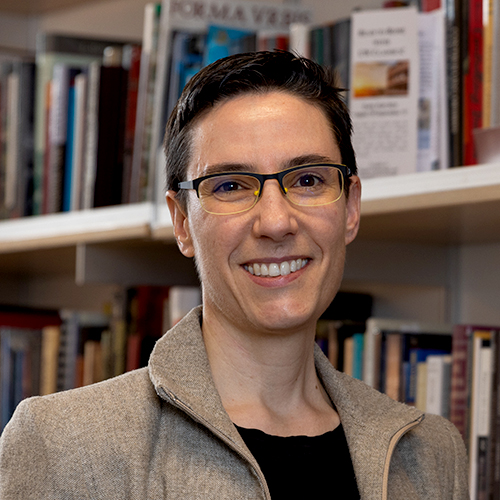From Lord of the Rings to Game of Thrones, a slew of fantasy novels—and their on-screen adaptations—take place in settings suggestive of the Middle Ages. So when curators at the EMP Museum (EMP) began planning an exhibit about the fantasy genre, they turned to medievalists at the UW for help.
Lane Eagles and Meagan Loftin, members of the Simpson Center for the Humanities’ Medieval Studies Graduate Interest Group, answered their call. For the past year, the two graduate students researched mythic archetypes for the exhibit Fantasy: Worlds of Myth and Magic, which opened at EMP on April 27.

It helps that both students are fantasy buffs. Loftin, a graduate student in English, describes herself as “old school—very steeped in Tolkien,” though she also enjoys Beowulf and other classic literature. Eagles, an art history graduate student, is a fan of Game of Thrones as well as the Arthurian legend and other works in the fantasy genre.
The pair tackled a long list of archetypes provided by EMP—everything from The Witch and The Damsel to The Shadow and The Trickster. They honed the list to 20 archetypes, prepared concise descriptions, and identified characters from the fantasy realm that fit each archetype. They then collected images and video clips of those characters, from gods in ancient literature to figures in contemporary fantasy, to demonstrate the salient qualities of each archetype.
“The curators wanted to establish archetypes of fantasy that are very familiar, many of which come from medieval and classical stories,” says Loftin. “It gave us a way to see how these character types have endured over such a long period.“ Adds Eagles, "Archetypes ended up being exactly the right kind of vehicle to get a wide audience to think about what writers like Tolkien and contemporary author Neil Gaiman have drawn from."
Take the example of the Damsel archetype. Eagles identified Andromeda in Greek mythology as a Damsel, but also Princess Buttercup in The Princess Bride. She found a painting to represent Andromeda; Buttercup required a bit more work. “I probably played and paused the film The Princess Bride 100 times to come up with a segment that best encapsulates the Damsel archetype,” recalls Eagles.

For Loftin, a favorite archetype is the Trickster, a staple of literature from many cultures. An obvious example is Loki, a trickster character from Norse mythology that has been resurrected through Marvel comics and in the recent film Thor. But Loftin also looked to West African folklore myths, where a spider named Anansi plays tricks that always backfire. She also identified Mary Poppins as a trickster, though the magical nanny did not make EMP’s final cut.
That Mary Poppins would even be considered for a fantasy exhibit might surprise people. But Loftin argues that while “high fantasy” tends toward the neo-medieval, the boundaries of the fantasy genre are much broader. “Something like Winnie the Pooh can be considered fantasy,” she says. (Pooh didn’t make it into the exhibit either.)
What makes a neo-medieval setting so popular for fantasy? Eagles and Loftin aren’t quite sure. “There’s no reason why fantasy has to be set in that world,” says Eagles. “There’s a fascination with that period but also a gross misunderstanding of it. A lot of what we know about the Middle Ages comes from Renaissance scholars who vilified the period, focusing on the destruction of the Roman Empire." Adds Loftin, “The medieval period is often represented as dirty and horrible: to call something ‘medieval’ is derogatory. But the tales of this period facilitate a weird connection with dragons and damsels in distress, which is great because it gets students interested in the medieval era.”
If this is what it took to put together one display, I can’t imagine what it took to do the whole exhibit.
Of course watching a show like HBO’s Game of Thrones (based on George R.R. Martin’s book series) and learning about the Middle Ages in a UW classroom are entirely different experiences. Loftin admits that bridging fantasy and medieval history “demands a certain re-education process,” but she finds that prospect less challenging than getting the uninitiated interested in the Middle Ages. “If students are already interested in medieval-inspired fantasy, you can help them understand the history,” she says. “Something that may seem boring on paper can come to life if you help them understand connections and parallels [with fantasy novels].”
Both Eagles and Loftin volunteered their time for the archetype research. Loftin welcomed it as a break from her dissertation research, describing the project as “a chance to step outside my bubble and do something else.” Eagles, who also researched forms of magic—from black magic to sympathetic magic—for another display in the exhibit, appreciated the opportunity to work with curators at EMP. “As a museum, EMP stands alone,” she says. "It's not a typical museum. It's not satisfied by simply preserving and displaying artifacts. Instead, it analyzes popular culture by immersing museumgoers into another world."

Visitors may not fully appreciate the research required for a major museum exhibit, but now Eagles and Loftin do. They will never look at an EMP display the same way again. “If this is what it took to put together one display, I can’t imagine what it took to do the whole exhibit,” says Loftin, who happily watched visitors crowd the interactive display about archetypes at the exhibit’s opening event.
And Eagles? Unfortunately she had to miss the opening. “School took priority,” she says. “I had to defend my master’s thesis that day. But I'm looking forward to seeing the exhibit as soon as I can.”
For more about Fantasy: Worlds of Myth and Magic, visit the EMP site at www.empmuseum.org.
Meagan Loftin shares more thoughts on the project in an interview for the Simpson Center for the Humanities. To read the interview, click here.
More Stories

Lifting Marginalized Voices — from Ancient Rome
"Interesting, frustrating, and necessary,” is how Sarah Levin-Richardson, professor of Classics, describes her research into the lives of enslaved individuals in the ancient world.

How a Chemistry Lab is Transforming Clinical Research
Ashleigh Theberge's UW lab creates bioanalytical chemistry tools. Some are transforming how clinical studies can be conducted.

Still Fascinated by Physics
"The questions are long-term questions," emeritus professor Marshall Baker says of his theoretical physics, which he is still pursuing at age 91.